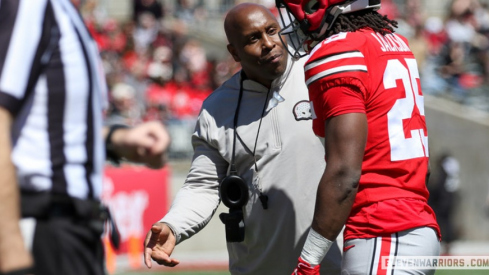
Our long national nightmare may finally be over. And we have the ACC, the unlikeliest of all organizations to thank.
For three years, teams have crisscrossed the nation, swapping conferences like t-shirts and jeans. Some joined leagues only to never even play one game in their new landing spot. Above all, traditions vanished and fans were marginalized all in the name of the almighty dollar.
But what seemed like a never-ending journey that would send college football into oblivion is nearing its final hour. On Monday, the ACC announced a landmark media rights deal that all 15 member schools – yes, the ACC now has 15 teams – are set to agree on.
The Grant of Rights will prevent fellow conferences from pilfering ACC schools because, in essence, it gives a team no value if it leaves. If a school decides to go elsewhere, it relinquishes its media rights. As we know, that is the No. 1 moneymaker in college athletics.
The deal coincides with the ACC’s current TV deal with ESPN, which expires after the 2026-27 season. What was once a $17 million deal for each school could rise to more than $20 million due to Notre Dame’s inclusion and the impending ACC Network.
In theory, an ACC member could still abandon the league. The costs, though, would be astronomical, making a measly exit fee seem like pocket change. All told, it could be a multi-hundred million-dollar mistake.
Recent rumors have centered on Virginia, Virginia Tech, North Carolina and Georgia Tech all being targeted by the Big Ten. With the ACC now being protected, significant moves by the Big Ten, Big 12 and SEC are likely done.
Since the feeding frenzy began in the summer of 2010, there has been virtually non-stop speculation about which team would the next to leap from one major conference to another. Now comes the first agreement to forcefully put the speculation on the backburner – at least for the next 15 years.
“This announcement further highlights the continued solidarity and commitment by our member institutions,” said ACC Commissioner John Swofford. “The Council of Presidents has shown tremendous leadership in insuring the ACC is extremely well positioned with unlimited potential.”
The Big Ten, Big 12 and Pac-12 have similar deals in place. If the Big Ten wants to expand further to 16 teams, the American Athletic Conference – formerly the Big East – is likely to be the source.
 "The ACC did what?"
"The ACC did what?"Two members of the new league that attract most of the gossip are Connecticut and Cincinnati. But neither is likely to be the 15th and 16th schools for the Big Ten, and the Big 12 has indicated it is happy with 10 teams. UConn and Cincinnati have not hidden their desire to be welcomed into the ACC, but the feeling does not appear to be mutual. The Bearcats went as far as to send a Christmas card to ACC headquarters. All they got in return was coal in their stocking.
Part of the ACC’s deal includes the forfeiture of revenue for all home games, even after a team leaves the conference. This is the second stiff penalty the conference has put in place in the past year. A $20 million exit fee was increased substantially to $50 million, though it didn’t stop Maryland from joining the mass exodus and accept an invitation from the Big Ten.
Maryland is now in the midst of a lawsuit with the ACC regarding the exit fee. Not surprisingly, the Terrapins don’t believe they should have to pay the full $50 million, while the conference office thinks otherwise.
So three years hence who, if anyone, are the winners? Athletic department coffers are certainly more full, and fledgling programs at Maryland, Rutgers, Missouri and Louisville have unquestionably reaped the rewards. It has all been at the expense of fans and 100 years of tradition.
With the Big Ten reportedly shedding the Leaders and Legends Divisions for East and West, Ohio State will play Maryland and Rutgers every season. The Buckeyes will have prolonged hiatuses from the likes of Illinois, Iowa and Wisconsin. Think about that long and hard. Teams that Ohio State has played for the better part of a century will only venture to Ohio Stadium once or twice a decade.
Just because there’s money to be made doesn’t mean you have to chase it, especially when the cons far outweigh the pros. It’s not as if the Big Ten or its member schools are hurting for an influx of cash. Keep in mind each school receives about $25 million alone from the Big Ten Network.
The addition of Nebraska was tolerable. The Cornhuskers have a rich football history, classic stadium, rabid fan base and are located in a cosmopolitan city. Nebraska also brought along several high-profile non-revenue sports, including women’s basketball.
Fans of Big Ten schools were excited to play the Cornhuskers and travel to Lincoln. A lengthy chapter of college football history books has been written there. The same can be said for Piscataway, N.J., which played host to the first college football game ever, in 1869 during the Grant Administration.
But the excitement among Big Ten fans, save for getting to travel to Washington and New York, is nearly nonexistent when the addition of Maryland and Rutgers is discussed. The schools bring little to the conference, other than the ability to ink a $150 million TV deal.
Even Maryland basketball, the school’s flagship program, has struggled most of the past decade, dating to a national championship in 2002. Rutgers’ football has seen a resurgence, but the Scarlet Knights are a non-factor in the national title picture.
Not to mention, the 18-game conference basketball schedule just become more clustered with a 14-team conference.
Oh, how could I forget? The Big Ten Network gains excellent programming. Who’s up for Big Ten Icons: Juan Dixon?
Get your popcorn ready.

